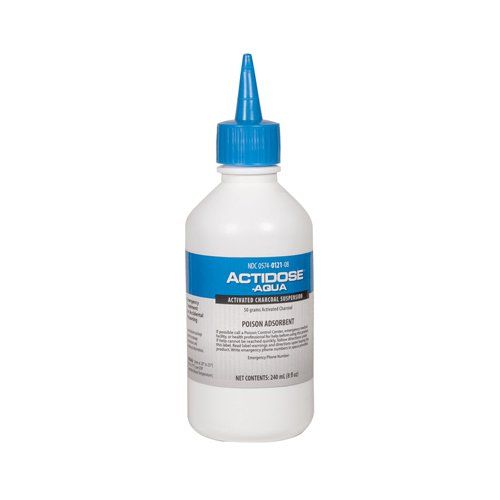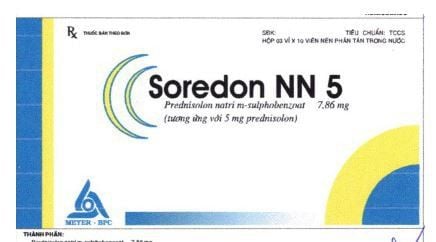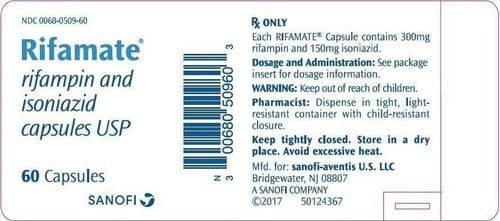This is an automatically translated article.
Cevita 100 belongs to the group of mineral and vitamin drugs. Drugs used to prevent and treat scurvy or cases where vitamin C supplementation is required. Follow the article below to know what is Cevita 100mg and in what cases is it indicated?
1. What is Cevita?
Cevita has the active ingredient Ascorbic Acid 100mg and other excipients such as Sodium metabisulfite, Sodium hydrocarbonate, Nipagin, Nipasol, distilled water for injection, just enough for 1 ampoule. The drug is packaged in the form of a box, each box of 10 blisters x 10 ampoules x 2ml.2. What are the effects of Cevita?
Active ingredient Vitamin C in Cevita medicine acts as an element, participating in the metabolism in the body. The drug brings benefits such as:
Participate in the metabolism of glucid, protid and lipid in the body. Helps anti-oxidant, scavenges free radicals (free radicals are the main source of aging, dangerous diseases such as cancer and cell membrane damage, ...) Supports synthesis of collagen, proteoglycan and many other components that form connective tissue in teeth, bones, vascular endothelium. Therefore, if vitamin C deficiency often causes bleeding gums and loose teeth, ... Increases the body's resistance, helps reduce stress because vitamins help promote the synthesis of interferon - substances that have an effect. Used against viruses, cancer cells, bacteria and parasites,...
3. Uses - indications and contraindications of Cevita
3.1 Uses - indications of the drug Treatment of scurvy, hemorrhagic symptoms such as: Slow wound healing due to vitamin C deficiency, bleeding gums and bruised patches due to bleeding under the skin. Used for patients with infection, poisoning, in pregnancy, fatigue need to increase the body's resistance,. Used for patients with iron deficiency anemia. 3.2 Contraindications of the drug Patients should not use Cevita if:
Lack of Glucose - 6 - phosphate dehydrogenase (G6PD) also known as hemolytic anemia. Patients with a history of kidney stones, hyperoxaluria, and oxalate metabolism disorders (increased risk of kidney stones) and patients with an increased risk of iron absorption (thalassaemia). Note: Contraindications here should be understood as absolute contraindications, not for any reason that these cases should be used.
4. How to use and dose of Cevita 100
4.1 How to take the drug Cetavi is in the form of ampoules and should be taken orally. However, the patient should use it exactly as directed by the doctor. In addition, in cases where it cannot be used orally, it can be administered intramuscularly or intravenously. If the injection is used, it is recommended to inject intramuscularly for the best, even though the injection will cause pain at the injection site.
4.2 Dosage of Cevita medicine For adults:
Used to treat scurvy: Dose 0.5 - 1g/day. Used to prevent scurvy: Dose 0.2 - 0.5 g/day. For children:
Used to treat scurvy: Dose 100 - 300mg/day Note: Do not use more than 1g/day. Users need to apply the exact dose of Cevita listed on the package, instruction sheet or prescription from a doctor or pharmacist. It is strictly forbidden to arbitrarily determine, apply or change the dosage.
5. How to deal with missed dose, overdose of Cevita 100
In case of missed dose: If user forgets to take Cevita medicine, skip that dose and continue taking the next dose as usual. Never use a double dose to make up for the missed dose, which can cause dangerous effects on the body. Users should also not skip more than 2 doses in a row.
In case of overdose: When using an overdose of Cevita, users may experience common symptoms such as nausea, kidney stones, gastritis and diarrhea. In addition, patients may also experience kidney and liver toxicity. With this dangerous symptom, the patient should be closely monitored for skin and facial manifestations, blood pressure measurement and high precaution because the disease can progress very quickly. The patient can be treated by infusion to help induce diuresis after taking more than the prescribed dose.
Ideally, in order for the patient's condition to improve, it is necessary to immediately notify the treating doctor for timely treatment.
6. Undesirable side effects of Cevita 100
Like most other drugs, when using Cevita, users may also experience some unwanted symptoms such as:
Common cases:
Increase in urinary oxalate. Rare cases:
Affects the cardiovascular system: Heart failure, flushing. Central nervous system effects: Fatigue, headache, dizziness and fainting. Effects on the digestive system: heartburn, nausea, vomiting and diarrhea. Effects on the nervous system, muscles, and bones: Rib pain. Effects on blood: Hemolytic anemia. Note: In addition to the above side effects, if users experience other side effects such as itching, redness or any other symptoms suspected to be caused by Cevita, please consult your treating doctor. for clarification and treatment.
7. Drug Interactions Cevita 100
Some drugs or functional foods that users should note or avoid while using Cevita include:
Aspirin: Concomitant use with vitamin C will increase the excretion of vitamin C and reduce the excretion of aspirin in the body. urine. Fluphenazine: Reduces fluphenazine plasma concentrations. After taking vitamin C can lead to changes in the excretion of other drugs. Affects many tests because vitamin C is a strong reducing agent. It artificially increases glucose if quantified with copper(II) sulfate reagent and artificially reduces glucose if quantified by glucose oxidase method. It is necessary to consult a doctor or document about the effects of vitamin C. Some notes when using Cevita 100. When using high doses of vitamin C for a long time, it will lead to the phenomenon of drug resistance. Therefore, when the dose is reduced, it will lead to vitamin C deficiency. When administered intravenously (unreasonably and unsafely) may lead to temporary or mild fainting. dizziness , more severe causes cardiac arrest. Users with glucose - 6 - phosphate dehalogenase deficiency who take high doses of vitamin C intravenously or orally may experience hemolysis. Deep vein thrombosis has also been reported after taking high doses of vitamin C. In the case of pregnant women: Vitamin C crosses the placenta. However, if vitamin C is taken according to normal daily requirements, no abnormality has been reported. It is not recommended to take large amounts of Vitamin C during pregnancy because it can increase the need for vitamin C, leading to scurvy in the newborn. In case of lactating women: Vitamin C is distributed in breast milk. If the normal dose is taken as needed, there should not be any problems for the infant. Effects on work: Does not affect the ability to drive, operate machinery, work at height and other cases. Note:
If you see Cevita 100 medicine with strange signs such as deformation, color change, watery, the patient absolutely must not use that medicine anymore. Cevita 100 should be stored in a place with moderate humidity, cool, away from direct sunlight. Keep out of sight of small children, avoid the children taking the medicine by themselves can cause unintended dangers. Hopefully, the information shared about the uses, usage and some notes of Cevita 100 will help users understand more details and feel more secure when using.
Please dial HOTLINE for more information or register for an appointment HERE. Download MyVinmec app to make appointments faster and to manage your bookings easily.













